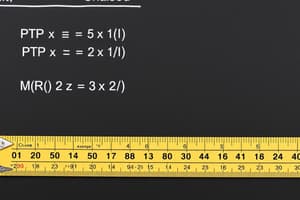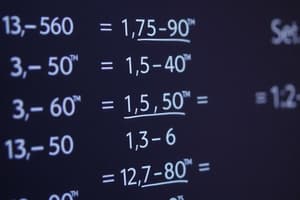Podcast
Questions and Answers
Which term describes how consistent a measurement is with itself?
Which term describes how consistent a measurement is with itself?
- Metric system
- Significant figures
- Accuracy
- Precision (correct)
In the metric system, what do prefixes like kilo-, hecto-, and centi- indicate?
In the metric system, what do prefixes like kilo-, hecto-, and centi- indicate?
- Multiples of 10
- Multiples of 100
- Fractions of 1000
- Powers of 10 (correct)
What is the primary difference between English units and SI units?
What is the primary difference between English units and SI units?
- English units have consistent prefixes for unit conversion.
- SI units use factors of 10 for calculations. (correct)
- The metric system is used in English units.
- SI units are based on decimal multiples.
What plays a crucial role in accurate and precise unit conversions?
What plays a crucial role in accurate and precise unit conversions?
Why was the metric system created?
Why was the metric system created?
Which of the following is NOT a fundamental unit in the International System of Units (SI)?
Which of the following is NOT a fundamental unit in the International System of Units (SI)?
What is the process of expressing a measurement with the correct number of significant figures called?
What is the process of expressing a measurement with the correct number of significant figures called?
If a measurement is reported as 2.345 m, how many significant figures does it have?
If a measurement is reported as 2.345 m, how many significant figures does it have?
Which of the following units is NOT part of the metric system?
Which of the following units is NOT part of the metric system?
If a measurement is reported as $5.67 \times 10^{-3}$ kg, what is the correct number of significant figures?
If a measurement is reported as $5.67 \times 10^{-3}$ kg, what is the correct number of significant figures?
Flashcards are hidden until you start studying
Study Notes
Physics Units and Measurements: Unit Conversions, Significant Figures, SI Units, and the Metric System
Suppose you've heard the phrase "physics is the study of the natural world," and you want to understand exactly what that means. Well, you're in luck! Here, we'll dive into the intriguing world of physics, focusing on key concepts related to units and measurements. We'll cover unit conversions, significant figures, SI units, and the metric system. So grab a cup of coffee, settle in, and join me on this exciting journey!
Definition of Measurements in Physics
Before diving into the details of specific units and measurement techniques, it's essential to understand the broader concept of measurements and their importance in physics. A measurement is a process of determining the value of a physical quantity by comparing it to a standard unit of measurement. Think of measuring the height of a book. You wouldn't use your own fingers to measure its height; instead, you would find a standard ruler and carefully align the book with the markings on the ruler to determine its length.
Units of Measurement
In physics, different types of units are used for measuring various physical quantities. These include fundamental units that represent the basic concepts of mass, length, and time; derived units that describe more complex properties such as force, energy, power, and angle; and supplementary units that help define angles in three dimensions.
Unit Systems
Two common systems of units are English units and SI units. While English units are still in use in some countries like the United States, most of the world, including scientists and engineers, has adopted the International System of Units (SI). SI units follow a metric system where values can be calculated with factors of 10.
Significant Figures
When making measurements, we aim for accuracy and precision. Precision refers to how consistent the measurement is with itself, while accuracy checks if the measured value agrees with an accepted reference value. To express this level of precision, the number of significant figures is used. The rules guiding the addition and subtraction of significant figures ensure consistency when performing calculations involving measured values.
Metric System
The metric system is based on decimal multiples and fractions of base units. It was created to simplify measurements by using consistent prefixes that indicate powers of 10, such as kilo-, hecto-, deca-, centi-, milli-, micro-, nano-, pico-, femto-, atto-, and zepto-. This system allows easy conversion between units of different magnitudes.
Unit Conversion
In the context of unit conversions, metrology plays a crucial role. Accurate and precise measurements require up-to-date standards maintained at national metrology institutes worldwide. The ongoing development of measurement techniques facilitates advancements in both scientific research and technological applications across diverse fields.
That's just a brief overview of the fascinating world of physics units and measurements. As we continue exploring, we'll delve deeper into each topic, providing even more captivating insights into this realm of science. So stay tuned!
Studying That Suits You
Use AI to generate personalized quizzes and flashcards to suit your learning preferences.




